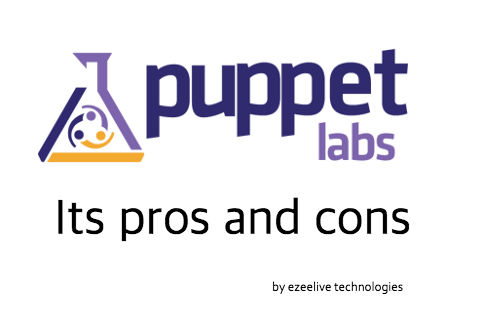What is Puppet IT Automation – Puppet Pros and Cons
What is Puppet?
Puppet is a software configuration management tool that is used mainly by system administrators and cloud administrators today. It helps an administrator declare the system configuration and apply it across one or many systems.
It is useful in growing complexity of IT infrastructure management and the increasing number of mundane, routine tasks that are involved in almost any setup. Puppet is an open-source tool under the Apache License 2.0 license.
What are Puppet Pros and Cons?
Traditionally, system administrators configured computers in a network separately, by carrying out the setup steps on each system locally. As the server-client architecture boomed, it was necessary to configure servers remotely and quickly.
It was still simple enough to be done by a human and by that time people started using some scripts to automate small chunks of tasks.
As the number of servers grew and the list of tasks to do a configuration grew with it, bigger teams were employed to administrate those servers. But there were too many tasks that now which were mundane but important for a successful configuration.

These problems were set to grow to bigger volumes with the advent of cloud computing. Also, servers started becoming more disparate with different platforms and operating systems coming into the picture.
How Puppet Works?
Puppet has a configuration language, which is simpler than a traditional programming language. It is more like a markup language such as XML.
A user uses this language to declare the items to be configured and the actions to be taken. This collection of instructions is saved as a ‘manifest’ file.
While the user is doing this, they do not need to worry about the actual underlying platform. This is due to the resource abstraction feature of Puppet.
To execute the configuration, Puppet picks the instructions while maintaining a graphical representation of the resources it has to act on (with their interdependencies). The configuration to be achieved (called the desired state) is achieved and the result of it is sent across to the server.
Puppet Advantages

Puppet is one the most popular configuration management tools around and has plenty of advantages.
1. Puppet is open source
It is important for a technology to be open source and hence be extendable. This is one of the biggest Puppet Pros. Puppet can be extended to build custom libraries and modules to suit the needs individual project.
2. Automation
Puppet allows for the automation of repetitive tasks involved in managing infrastructure, such as configuration changes, software installation, and updates. This automation reduces human error and saves time by eliminating the need for manual intervention.
3. Consistency
With Puppet, you can define the desired state of your infrastructure using code (in Puppet’s domain-specific language), ensuring consistency across all your servers and environments. This consistency helps maintain stability and reliability in your infrastructure.
4. Scalability
Puppet is designed to scale from small to large infrastructures, making it suitable for organizations of all sizes. Whether you have a handful of servers or thousands, Puppet can efficiently manage them.
5. Reusability
Puppet’s modular architecture allows you to create reusable components called modules. Modules encapsulate configuration logic and can be shared across teams and organizations via Puppet Forge, a repository for Puppet modules. This encourages code reuse and standardization.
6. Version Control

Puppet code can be managed using version control systems such as Git, enabling you to track changes, collaborate with teammates, and roll back to previous configurations if needed. This ensures transparency and accountability in managing infrastructure changes.
7. Reporting and Monitoring
Puppet provides reporting and monitoring capabilities that give insights into the state of your infrastructure. You can track changes, detect drifts from the desired configuration, and troubleshoot issues more effectively.
8. Puppet allows resource abstraction
It is possible for a configuration task today to be needed across a range of servers that all have different operating systems and other platform specific identities.
Hoping that a system administrator actually remembers the commands and syntax of the individual platforms and reproducing that error-free is hoping for a lot.
Puppet doesn’t need one to do that since it derives the system specific data using a utility called Factor. Factor helps Puppet know the system details like operating system, IP address etc. that helps Puppet achieve abstraction.
9. Puppet does a transaction only if needed
When the number of servers is as large as some systems have today, it is possible to encounter some form of redundancy. It is possible to have an instruction that doesn’t bring about any change in the system.
Puppet has the feature of ‘idempotency’ which means it applies the changes asked for only when the changes would actually change something in the system. If the changes asked for are already done, Puppet doesn’t do anything. This is useful for achieving efficiency.
10. Puppet boosts manageability and productivity

Puppet achieves significant improvements to the productivity of the system administrators. They are freed up from their mundane tasks and can actually concentrate on more advanced tasks that require human intervention. It also helps the server become more manageable with lesser effort and time.
11. Puppet is cross-platform
Puppet works on Fedora, RHEL, Debian, Gentoo, Solaris, OS X, and Windows. It helps the user to cover a wider range of platforms which makes more servers come into the configuration fold.
12. Puppet’s language is clean and easily learnable
Puppet’s declarative language is quite easy like writing an XML file. A person with limited programming knowledge can easily pick it up.
13. Puppet has cron-like support
Puppet can also help schedule specific maintenance actions on a periodic basis. This helps the administrators carry out some cronjobs in the maintenance cycle.
14. Puppet has override mechanism
The language supports a mechanism to override an instruction with a specific one for a different scenario. This is useful when exceptions are to be made while applying the configuration.
15. Puppet has an active community
It has an active and popular community with plenty of active discussion boards, forums and experts willing to help out.
Puppet Disadvantages
For all its advantages, Puppet has a few following drawbacks as well:
- Ruby can be complex to understand
- If one wants to extend Puppet, one has to work with Ruby (which Puppet is written in) and it may not be easy as Ruby is not hugely popular.
- Rapid releases and evolution
- Puppet releases new versions quite fast, and it can be quite a task to keep up with the new features and breaking changes (if any).
- Puppet doesn’t have comprehensive reporting features
- It is not possible to look at comprehensive reports on the transactions that Puppet carries out. Those features are still upcoming and not very mature.
- Puppet may not be suitable for smaller setups and businesses
- Smaller setups have seen more success with Chef and Ansible and do not prefer Puppet to avoid complexity.
- Puppet can be difficult for those new to programming
- This is not exactly a con but people who do system administration may not be versed with programming. They can find puppet a bit daunting to start with.
-
Resource Intensive
Puppet’s agent-based architecture requires resources (CPU, memory, network bandwidth) on managed nodes to run Puppet agents and apply configurations. This overhead can be significant, especially in large environments with thousands of nodes.
-
Dependency Management
Puppet relies on external dependencies, such as Ruby and various system libraries, which need to be managed and maintained. Updates to these dependencies may introduce compatibility issues or require manual intervention to resolve.
-
Performance
While Puppet is designed to be efficient, the performance of Puppet runs can degrade as the size and complexity of the infrastructure increase. Longer convergence times and delays in applying configurations may impact operational efficiency.
-
Limited Real-Time Capabilities
Puppet operates in a pull-based model where agents periodically check in with the Puppet master server for updates. This can result in delays between configuration changes and their application, limiting Puppet’s suitability for real-time or near-real-time requirements.
-
Single Point of Failure
The Puppet master server serves as a central point of control for configuration management. If the Puppet master becomes unavailable or experiences issues, it can disrupt the management of the entire infrastructure until the issue is resolved.
-
Lack of Native Windows Support
While Puppet does support Windows environments, its support for Windows is not as robust as for Unix/Linux systems. Managing Windows nodes with Puppet may require additional effort and configuration.
-
Community vs. Enterprise Features
Some advanced features and functionalities, such as role-based access control (RBAC) and high availability, are only available in Puppet’s enterprise offering, which may require a separate licensing cost.
-
Competitive Landscape
The configuration management and automation space are competitive, with several alternatives to Puppet available, such as Chef, Ansible, and SaltStack. Organizations may need to evaluate multiple tools to determine the best fit for their specific requirements.
Puppet vs Terraform
When managing IT infrastructure, selecting the right automation tool is crucial for efficiency, scalability, and consistency. Puppet and Terraform are two popular tools that serve different but sometimes overlapping purposes in the DevOps ecosystem. While Puppet is primarily used for configuration management, Terraform focuses on infrastructure provisioning. Understanding their core differences can help teams choose the right tool based on their specific needs.
| Feature | Puppet | Terraform |
|---|---|---|
| Category | Configuration Management | Infrastructure as Code (IaC) / Provisioning Tool |
| Developed By | Puppet Labs | HashiCorp |
| Language Used | Puppet DSL (Domain Specific Language) | HCL (HashiCorp Configuration Language) |
| Primary Purpose | Automate configuration and deployment of software | Provisioning and managing infrastructure |
| Procedural vs Declarative | Declarative (with some procedural capabilities) | Declarative |
| Mutable vs Immutable | Mutable infrastructure | Immutable infrastructure |
| Agent-based | Agent-based (with optional agentless mode) | Agentless |
| State Management | Partial (does not track full infrastructure state) | Maintains full state of infrastructure |
| Orchestration Capabilities | Yes, with tools like Puppet Bolt | Limited; focuses more on provisioning |
| Cloud Provider Support | Limited (requires integrations/modules) | Native support for AWS, Azure, GCP, and many others |
| Learning Curve | Moderate to steep (especially Puppet DSL) | Moderate (HCL is relatively easy to learn) |
| Community & Ecosystem | Mature, large community, many existing modules | Rapidly growing, strong plugin ecosystem |
| Best Suited For | Managing configurations across existing servers | Provisioning and managing infrastructure from scratch |
| Integration with Other Tools | Integrates with tools like Foreman, Jenkins | Easily integrates with CI/CD, GitOps, monitoring tools |
| Use Cases | Installing packages, managing users, configuring services | Creating VPCs, provisioning servers, load balancers, etc. |
Puppet vs Ansible
When automating configuration management and software deployment, both Puppet and Ansible are widely adopted tools in the DevOps ecosystem. While they aim to simplify infrastructure automation, they differ significantly in architecture, ease of use, and operational model. Choosing between them often depends on your team’s preferences, existing infrastructure, and specific use cases.
| Feature | Puppet | Ansible |
|---|---|---|
| Category | Configuration Management | Configuration Management & Automation |
| Developed By | Puppet Labs | Red Hat |
| Language Used | Puppet DSL (Ruby-based) | YAML (Ansible Playbooks) |
| Architecture | Agent-based (can be agentless with Puppet Bolt) | Agentless (uses SSH or WinRM) |
| Setup Complexity | More complex (requires Puppet Master/Agent setup) | Simpler (no agents, easier to set up and use) |
| Ease of Use | Moderate to steep learning curve | Easier for beginners, readable syntax |
| Execution Mode | Pull-based (agents pull configurations) | Push-based (controller pushes configurations) |
| Idempotency | Built-in idempotency | Built-in idempotency |
| Scalability | Highly scalable for large infrastructures | Scalable, but can face performance limits in large setups |
| State Management | Maintains state | Stateless (does not maintain state) |
| Speed | Slower due to pull-based and agent communication | Faster for small to medium environments |
| Orchestration | Available via Puppet Bolt | Native support for orchestration and workflows |
| Community & Ecosystem | Mature with many existing modules | Large and active community, rich ecosystem |
| Best Suited For | Complex, large-scale infrastructures | Quick automation, cloud provisioning, smaller environments |
| Use Cases | Managing OS configurations, packages, and users | Configuration, cloud automation, ad-hoc tasks |
Puppet vs Chef
Puppet and Chef are two of the most established configuration management tools in the DevOps world. Both are designed to automate infrastructure management, ensure consistency across environments, and reduce manual intervention. While they share many similarities, they differ in language, architecture, and user experience, making each more suitable for different teams and use cases.
| Feature | Puppet | Chef |
|---|---|---|
| Category | Configuration Management | Configuration Management |
| Developed By | Puppet Labs | Progress (originally by Opscode) |
| Language Used | Puppet DSL (Ruby-based) | Ruby (uses Ruby DSL) |
| Architecture | Client-server (Agent/Master) | Client-server (Chef Client/Chef Server) |
| Setup Complexity | Moderate to complex | Moderate to complex |
| Ease of Use | Easier due to declarative language | Steeper learning curve due to Ruby syntax |
| Execution Model | Declarative (describes desired state) | Imperative (describes how to reach desired state) |
| Agent-based | Yes (optional agentless with Puppet Bolt) | Yes (Chef Client runs on nodes) |
| State Management | Maintains state | Does not maintain full state (depends on node runs) |
| Idempotency | Built-in idempotency | Built-in idempotency |
| Pull vs Push | Pull-based (nodes pull from server) | Pull-based (nodes pull from Chef Server) |
| Community & Ecosystem | Mature with many modules (Puppet Forge) | Mature with extensive cookbooks (Chef Supermarket) |
| Orchestration | Puppet Bolt for orchestration | Chef Automate for workflows and compliance |
| Best Suited For | Teams preferring declarative syntax and stateful config | Teams familiar with Ruby and needing flexible workflows |
| Use Cases | Automating configuration of large-scale environments | Automating complex tasks, managing diverse infrastructure |
Conclusion
Puppet is a powerful and widely-used configuration management tool that streamlines IT automating the tasks of server management both on the premise and on the cloud. Puppet is a great tool to have on the stack to also ensure continuous (and quicker) delivery. Its declarative language, scalability, and extensive community support make it a reliable choice for managing complex environments.
Puppet advantages include consistent configuration across systems, reduced manual errors, and improved deployment speed. Among the key Puppet pros are its strong reporting capabilities, cross-platform support, and integration with other DevOps tools. Whether for small-scale setups or large enterprise systems, Puppet offers a robust solution for maintaining infrastructure as code.





Comment (1)
thank you it was helpful